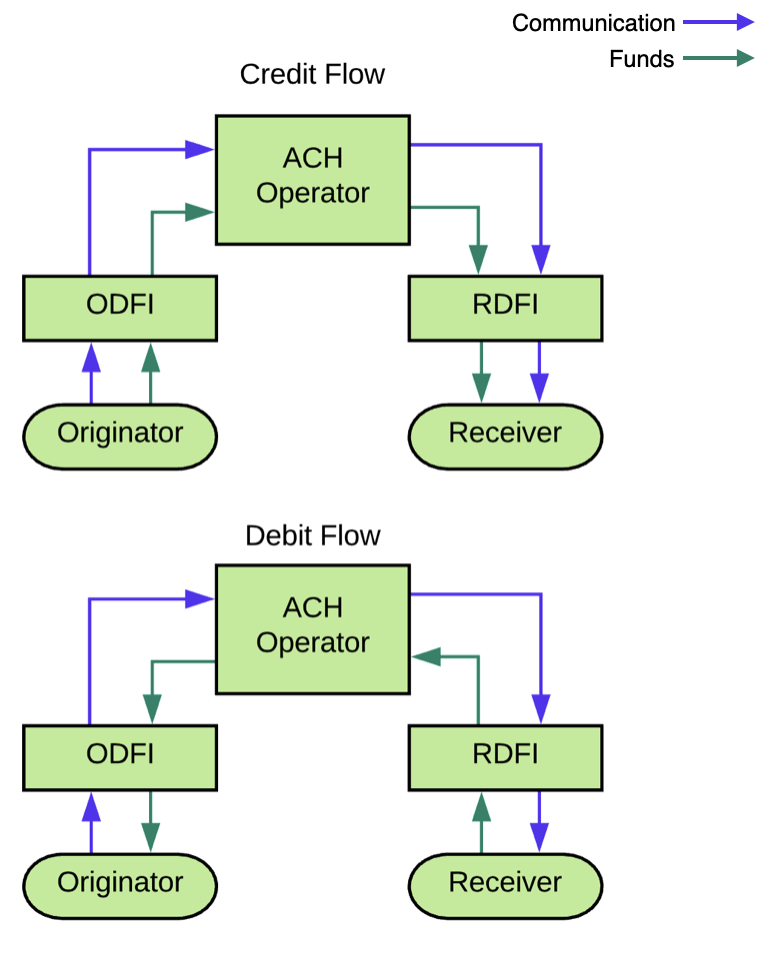What is ACH
What is an ACH transfer and how do we use them.
What is an ACH transfer
ACH transfer requests are sent from the bank acting as the ODFI and are received by the bank acting as the RDFI. Successful transfer requests move funds between an originator account at the ODFI and a destination account at the RDFI. The ODFI sends a batch of ACH files representing ACH requests to the ACH Operator. The ACH Operator then processes the requests and sends them to the appropriate RDFI. The RDFI credits or debits the receiver account.
Every transfer or attempted transfer is defined by its ACH return code.
The diagram below illustrates this flow.

The Bond platform handles the creation and transmission of the ACH file formatted with appropriate parameters to the ACH operator.
ACH class code
Every ACH transaction is classified with a single, 3-letter, ACH class or SEC code. The SEC code is a mandatory parameter that identifies the transaction type in an ACH transfer request. It identifies the ACH file format and specifies the authorization method for the receiver account. SEC codes distinguish between consumer and commercial usage categories.
NACHA, the regulatory body governing the ACH network, maintains and provides the complete list of SEC codes.
Bond supports the following SEC codes:
- ARC—Accounts Receivable Conversion
- CBR—Cross Border Entry (corporate)
- CCD—Cash Concentration or Disbursement
- CIE—Customer Initiated Entry
- COR—Notification of Change (NOC) or Refused NOC
- CTX—Corporate Trade Exchange
- IAT—International ACH Transactions
- MTE—Machine Transfer Entry
- PBR—Cross Border Entry (consumer)
- POP—Point-of-Purchase Entry
- POS—Point-of-Sale Entry
- PPD—Prearranged Payment and Deposit
- RCK—Represented Check
- TEL—Telephone-Initiated Entry
- WEB—Internet-Initiated Entry
Fund authorization
Following an ACH request made through our API, a settlement hold is placed on the originator account equal to the amount of the ACH transfer, before the transfer moves into a completed status. The table below summarizes the settlement windows.
| ACH Network | Hold Expiry |
|---|---|
| Standard ACH | 4 business days |
| Same-day ACH | 2 business days |
ACH submission cut-off times
ACH transfers must be submitted before certain cut-off times to ensure that the transfers are included in the appropriate NACHA batch files. The table below summarizes the cut-off times depending on the network.
| ACH Network | Cut-off Time |
|---|---|
| Standard ACH Origination | 8:00 pm CT |
| Same-day ACH Origination | 10:00 am CT |
If same_day ACH transfers are sent between the above cut-off times, the transfer will be treated as a standard ACH transfer. The receiving bank will receive the transfer first thing the following morning, and it will be available to the receiver at the open of business.
If same-day ACH transfers are sent after the standard ACH cut-off, the transfer will process as a same-day ACH transfer on the following business day.
ACH transfer state
Transfer status may be:
pendingcompletedfailedreturned
For more information, see Transaction states.
A created transfer is pending and becomes completed after it posts.
If a transfer is failed, a failure_reason is shown.
After a transfer has posted, it might still be returned. This reversal can only ever happen after a transaction has already completed.
If a transfer is returned, in addition to the failure_reason there will also be an ach_return_code. These ACH return codes are standard and are described in ACH return codes.
Reversing transfers
Reversing a transaction after it has reached the ODFI can only be done under specific circumstances. A reversal must occur within 5 business days of the transaction and is only considered for the following reasons:
- The transaction was for the wrong amount.
- The provided account number was incorrect.
- The transaction is a duplicate.
For a complete specification and interactive examples, see Creating a transfer in the Bond API Reference.
Funds availablity when transferring from an external bank account
When funds are transferred from an external account to an account managed by Bond, the funds are available as soon as the transfer arrives at Bond. Timing is dependent on the external originating bank.
Updated over 3 years ago
